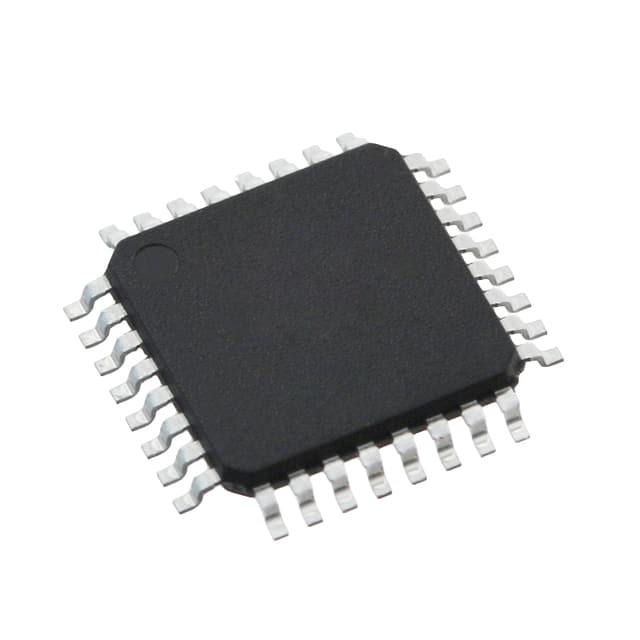Xem thông số kỹ thuật để biết chi tiết sản phẩm.

ATMEGA328PB-AU
Introduction
The ATMEGA328PB-AU is a microcontroller belonging to the ATmega series, which is developed by Microchip Technology. This versatile microcontroller is widely used in various electronic applications due to its advanced features and capabilities.
Basic Information Overview
- Category: Microcontroller
- Use: Embedded systems, IoT devices, consumer electronics
- Characteristics: Low power consumption, high performance, versatile I/O capabilities
- Package: TQFP-32
- Essence: The ATMEGA328PB-AU is at the core of many electronic devices, providing processing power and control.
- Packaging/Quantity: Available in tape and reel packaging with varying quantities.
Specifications
- Architecture: 8-bit AVR
- Flash Memory: 32KB
- SRAM: 2KB
- EEPROM: 1KB
- Operating Voltage: 1.8V - 5.5V
- Max CPU Speed: 20MHz
- I/O Pins: 23
- Communication Interfaces: UART, SPI, I2C
- Analog Inputs: 6 channels
- Timers: 3 (8-bit), 1 (16-bit)
Detailed Pin Configuration
The ATMEGA328PB-AU features a total of 32 pins, each serving specific functions related to input/output, communication, and power supply. A detailed pinout diagram is available in the datasheet provided by Microchip Technology.
Functional Features
- Enhanced Peripheral Functions: The ATMEGA328PB-AU includes additional peripheral modules compared to its predecessor, offering enhanced functionality for various applications.
- Low Power Consumption: With multiple sleep modes and efficient power management, this microcontroller is suitable for battery-powered devices.
- Versatile I/O Capabilities: The numerous I/O pins and communication interfaces enable flexible interfacing with external components and sensors.
Advantages and Disadvantages
Advantages
- Enhanced peripheral functions
- Low power consumption
- Versatile I/O capabilities
Disadvantages
- Limited memory compared to higher-end microcontrollers
- Limited number of timers for complex timing requirements
Working Principles
The ATMEGA328PB-AU operates based on the AVR architecture, utilizing a combination of RISC and Harvard architecture principles. It executes instructions stored in its flash memory, interacts with peripherals, and manages I/O operations to perform the desired tasks within an embedded system.
Detailed Application Field Plans
The ATMEGA328PB-AU finds extensive use in various application fields, including: - IoT Devices: Providing control and connectivity for IoT nodes and edge devices. - Consumer Electronics: Powering smart home devices, wearables, and entertainment systems. - Industrial Automation: Controlling and monitoring industrial equipment and machinery.
Detailed and Complete Alternative Models
- ATMEGA328P: The predecessor of ATMEGA328PB-AU, offering similar features with some differences in peripheral modules.
- ATMEGA32U4: Another member of the ATmega series with USB connectivity and more advanced peripherals.
In conclusion, the ATMEGA328PB-AU stands as a versatile and capable microcontroller, catering to a wide range of embedded system and electronic device applications. Its enhanced peripheral functions, low power consumption, and versatile I/O capabilities make it a popular choice among developers and engineers.
[Word Count: 529]
Liệt kê 10 câu hỏi và câu trả lời thường gặp liên quan đến ứng dụng ATMEGA328PB-AU trong giải pháp kỹ thuật
What is the ATMEGA328PB-AU?
- The ATMEGA328PB-AU is a high-performance, low-power 8-bit microcontroller based on the AVR enhanced RISC architecture.
What are the key features of the ATMEGA328PB-AU?
- Some key features include 32KB of in-system self-programmable flash memory, 1KB EEPROM, 2KB SRAM, 23 general-purpose I/O lines, and more.
How is the ATMEGA328PB-AU typically used in technical solutions?
- It is commonly used in various embedded systems, IoT devices, consumer electronics, and industrial control applications.
What are the programming options for the ATMEGA328PB-AU?
- The microcontroller can be programmed using various development environments such as Atmel Studio, Arduino IDE, or other compatible tools.
What communication interfaces does the ATMEGA328PB-AU support?
- It supports SPI, I2C, USART, and other communication interfaces, making it suitable for interfacing with a wide range of peripheral devices.
What are the power requirements for the ATMEGA328PB-AU?
- It operates at a voltage range of 1.8V to 5.5V, making it versatile for different power supply configurations.
Can the ATMEGA328PB-AU be used in battery-powered applications?
- Yes, its low-power consumption makes it suitable for battery-powered applications, extending the device's operational lifetime.
Are there any development boards available for prototyping with the ATMEGA328PB-AU?
- Yes, there are development boards specifically designed for the ATMEGA328PB-AU, providing an easy platform for prototyping and testing.
What are the typical clock frequency options for the ATMEGA328PB-AU?
- It can operate at various clock frequencies, including internal 8MHz oscillator, external crystal, or resonator options.
Is the ATMEGA328PB-AU suitable for industrial applications?
- Yes, it is suitable for industrial applications due to its robust design, reliability, and compatibility with industrial communication protocols.
Feel free to ask if you need further details on any of these questions!

